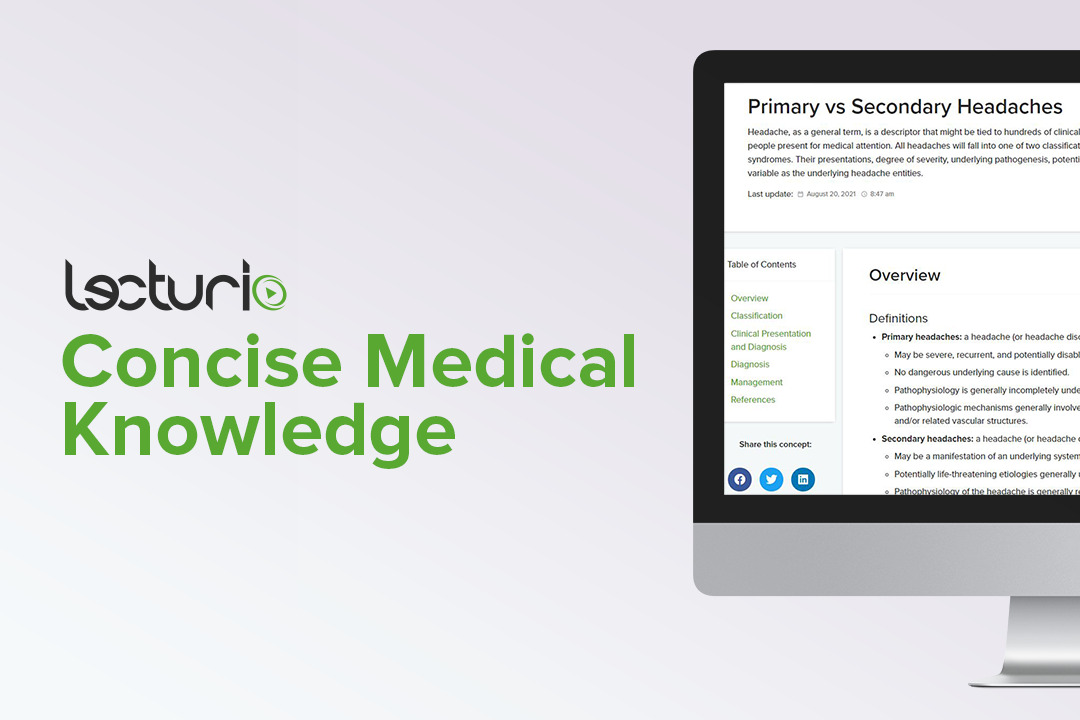Playlist
Show Playlist
Hide Playlist
Cluster Headaches
-
Slides Headaches Paroxysmal Episodic Headaches.pdf
-
Download Lecture Overview
00:01 Let's start with the cluster and understand a little bit more about cluster. 00:05 Cluster causes severe often very severe unilateral orbital or supra-orbital head pain that may also spread into the temporal region with episodes lasting 15-180 minutes without treatment. 00:20 The headache is accompanied by ipsilateral conjunctival injection, nasal congestion, rhinorrhea, eyelid edema, facial sweating, miosis or change in pupillary ptosis or a sense of agitation. 00:32 You can see the prominent autonomic features that characterize this condition. 00:37 Attack frequency is often every other day to 8 attacks in a day and they cluster around the evening or nocturnally. 00:46 They cannot be attributed to another disorder and patients must have at least 5 attacks, meeting the above criteria. 00:52 So they need these clusters where they have attacks every other day to 8 per day for a period of weeks, and must have 5 attacks meeting those criteria. 01:02 The differential diagnosis for cluster is quite long. 01:06 We can see other headache syndromes other TACS- episodic paroxysmal hemicrania which we'll talk about. 01:12 Trigeminal neuralgia, hypnic headache, idiopathic stabbing headache, as well as secondary causes of headache. 01:18 Tolosa-hunt syndrome, acute-angle glaucoma, trigeminal neuralgia, tumors of the pituitary/parasellar region, meningioma. 01:27 Vascular abnormalities like arteriovenous malformations or dissection. 01:31 And so patients who are concerned about a secondary cause do undergo imaging prior to management or often contemporaneous to at the same time as management to rule out some of these secondary causes when evaluating a patient with cluster. 01:46 In addition, we can see infectious causes maxillary sinusitis, and trauma. 01:53 What are some of the clinical features of cluster? Alcohol, nitroglycerin and histamine can trigger attacks during the cluster period. 02:01 But not in between the cluster attacks. 02:05 Patients will have episodes where they cluster and then that will be interspersed with a headache free interval that can last months or even years. 02:14 And in between those episodes of attacks, we don't see these triggers. 02:19 Increased blood histamine can be seen, there's an associated with a gastric acid secretion and peptic ulcer disease is more common. 02:26 There's also an associate with obstructive sleep apnea that may be related to some of the brainstem abnormalities and circuitry and melatonin dysfunction that we see in these patients. 02:35 We can see increased intraocular pressure, decreased nocturnal melatonin. 02:40 There's a nocturnal predominance of these and increased juggler CGRP as well as vasoactive intestinal peptide. 02:48 Treatment of cluster is very important and oral medications are ineffective. 02:53 They don't act quickly enough. 02:54 Again, the headaches last 15-180 minutes. 02:58 So by the time the patient has gone to get the pill, the headache may be gone but the headache is severe and does require treatment. 03:05 Typically, we think about subcutaneous or nasal triptans like sumatriptan. 03:10 This is fast acting and fast onset and so it can be used for patients right when they have the onset of that cluster. 03:17 Oxygen by nasal canula or facemask can be very effective. 03:21 Other agents can include the oral triptans. 03:24 They are very fast acting nasal DHE, lidocaine, olanzapine can be used. 03:30 A number of other agents have been tried and analgesics are usually ineffective for these patients and should not be used. 03:38 In patients who have refractory symptoms that do not respond to treatment, sometimes we consider more interventional approaches, occipital nerve blocks or other nerve blocks. 03:48 Superficial temporal artery injection or ligation can be considered in rare cases. 03:54 Ganglion neurolysis can be considered, deep brain stimulation and Botox. 03:58 Again, for patients who are particularly refractory, we would consider escalation to some of these more interventional approaches. 04:05 What about prophylaxis? This is very important for these patients who will have clusters of headaches that are quite severe. 04:11 There's a number of medicines that have good data to support their use. 04:14 Verapamil is one that we think about. 04:16 It's effective in episodic and chronic forms of cluster with few adverse effects though you can see those here. 04:23 Lithium is used and this is one of the more effective agents to treat chronic cluster. 04:28 It does have a narrow therapeutic margin therapeutic index. 04:32 And so we do follow levels in those patients to make sure they're not super therapeutic. 04:36 And then a number of other agents that you see here both in and outside the United States can be used. 04:41 The ergotamine derivatives have been used. 04:42 Sometimes we consider prednisone, topiramate as a second or more ladder agent that we would consider in addition to gabapentin and valproic acid.
About the Lecture
The lecture Cluster Headaches by Roy Strowd, MD is from the course Headache.
Included Quiz Questions
What is a common trigger for cluster headaches?
- Histamine
- Smoking
- Increase in blood pressure
- Bright lights
- Strong odors
What is an appropriate abortive treatment for cluster headaches?
- Oxygen
- Naproxen
- Topiramate
- Tricyclic antidepressants
- Gabapentin
Customer reviews
5,0 of 5 stars
| 5 Stars |
|
5 |
| 4 Stars |
|
0 |
| 3 Stars |
|
0 |
| 2 Stars |
|
0 |
| 1 Star |
|
0 |




